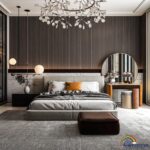
Louver Wall Designs for Indian Homes | Ideas by 91Homes
If you’ve been browsing through modern home interior photos lately, you must have noticed a common element — Louver Designs. Whether you call them WPC louvers, PVC louvers, or wooden panels, they’re all part of this trending wall décor style. But what exactly are louvers? Where should you install them? And how do you choose the right type?
In this blog, we’ll break down everything you need to know before installing louver panels in your home — types, materials, prices, advantages, disadvantages, and design tips.
What Are Louver Designs?
Louver panels are decorative wall panels with “+/-” style grooves or spaced slats that create a layered, textured look. They can be made from various materials and come in multiple sizes, thicknesses, and finishes — wooden textures, plain solid colors, marble effects, and more.
Types of Louvers Available in the Market
1. PVC Louvers – Budget-Friendly and Lightweight
Best for: Rental properties, quick décor upgrades
Size: Usually 6″ x 8 ft
Price Range: ₹300–₹400 per panel
Advantages:
Most affordable
Lightweight and easy to install
Available in various colors and patterns
Disadvantages:
Very thin and hollow — prone to damage
Gives a plasticky, non-premium feel
Limited design variation (single or dual-tone)
Not weather-resistant — fades outdoors
✅ Use indoors only, avoid in high-traffic or outdoor areas.
2. WPC Louvers – Strong and Weatherproof
Best for: Balconies, bathrooms, outdoor use
Material: Wood Polymer Composite (mix of wood & plastic)
Thickness: ~6 mm
Price Range: ₹500–₹1200 per panel
Advantages:
Durable and weatherproof
Suitable for both indoor and outdoor use
Better strength than PVC
Disadvantages:
Pricier than PVC
Limited design options (mostly monochrome or dual-tone)
3. Charcoal Louvers – Premium Look with Variety
Best for: Bedrooms, living rooms, accent walls
Material: Solid, filled structure (not hollow)
Price Range: ₹700–₹1800 per panel
Advantages:
Highly durable
Massive variety in shapes and designs
Vibrant color options
Disadvantages:
Expensive compared to PVC and WPC
Some variants may not be weatherproof (ask before buying)
✅ Ideal for high-end residential interiors.
4. SS (Stainless Steel) PVD-Coated Louvers – Ultra-Luxury
Best for: Banquet halls, commercial spaces
Finish: Shiny, metallic, mirror-like
Price Range: ₹1000–₹4000 per panel
Advantages:
Very luxurious and eye-catching
Disadvantages:
Very costly
Limited color/design options
Not commonly used in homes
Where to Use Louvers in Your Home?
| Space | Recommended Type | Why? |
|---|---|---|
| Bedroom | Charcoal or WPC | Design variety + strength |
| Living Room | Charcoal | Better design appeal than WPC |
| Balcony | WPC or outdoor-grade Charcoal | Weatherproof and strong |
| Bathroom | WPC | Fully waterproof |
| Rental Home | PVC | Affordable and decent for basic decor |
Design Tips for Louvers in Bedrooms
For Small Bedrooms (Wall ≤ 9 ft)
Avoid full-wall louvers — makes the room look cramped
Use an L-shape design in one corner (30% wall + 20% adjacent wall)
Add a stylish lamp for extra charm
For Medium Bedrooms (10–12 ft Wall)
Install louvers only above side tables (2–3 ft left and right of the bed)
No need to cover the entire wall
For Large Bedrooms (12–15 ft Wall)
Keep the center for bed + side tables
Add louvers only in the leftover 3 ft on each side
Add lights above the louver panels
For Extra-Large Bedrooms (>15 ft Wall)
Consider top-half louvers only (leave 4 ft at the bottom)
You can go full width if the room is very spacious
Louver Installation Guide
Surface requirement: Install only on flat walls
If your wall has waves or undulations:
Use a 12mm commercial plywood base (MR Ply) to flatten it
Fixing method:
Use interlocking clips screwed to the wall
Louvers are snapped into these clips
Labour cost: ~₹300 per panel (negotiable)
Most louver sellers can arrange installation too
Common Mistakes to Avoid
Using PVC Louvers Outdoors: They fade and crack quickly.
Covering Entire Walls: Keep louver coverage ≤ 40% of the wall area.
Covering Damp/Seepage Areas: Moisture builds up behind louvers — leads to fungus and odor.
Using Harsh Cleaners: Only use a damp cloth — avoid acids or detergents.
Installing on Uneven Surfaces: Screws loosen over time — panels will warp.
Not Testing in Room Lighting: Always test 1 sample panel at home before finalizing.
Incorrect Cutouts for Switches: Always cut slightly smaller than the switch plate to hide edges.
Conclusion: Should You Go for Louvers?
Absolutely — if chosen wisely. Louver panels can elevate your space and add an architectural touch, but only when selected based on room size, design preference, and material suitability.
Thinking of getting louvers for your home?
👉 Click here to speak directly with our interior design experts at 91Homes. We’ll help you select the perfect louver style and integrate it beautifully into your interiors.
